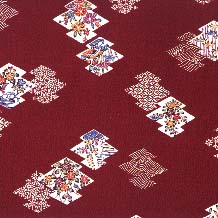Dye (p. 108 )
1. Produced in Kyoto City, Kyoto -Fu.
2. Characteristics: "Yuzen dye" with paper patterns and "Utsushi Nori," blend of dye and glue. The name is an abbreviation of "Katagami(paper pattern) Yuzen Zome(dye)." It is also called "Itaba Yuzen." As the technique is different from "Itome Yuzen," there is no "Itome"(thread line). Capable of mass production, the price of "Kata Yuzen" is lower than "Tegaki(hand dyed) Yuzen."
3. Uses: Clothing, undergarments, clothes for the 7-5-3 Festival, lining cloths for "Haori"(coat for Kimonos).
4. History: The production of "Kata Yuzen" is said to have started around 1880, when Jisuke Hirose, master craftsman of "Sashi Yuzen"(dyeing with a brush), applied to silk fabrics the technique invented by Shinzaburo Horikawa in Kyoto, which was for dyeing muslin with "Utsusi Nori." "Kata Yuzen" caused the price of Yuzen to drop and also it became popular among the common people. Most of the Yuzen produced today is "Kata Yuzen."
Dyeing Method
1. The paper pattern is placed on white cloth.
2. "Utsushi Nori," which is also called "Iro Nori,"(colored glue), mixture of chemical dyes and glue, is applied on the pattern with a spatula.
3.The cloth is steamed to fix the dye to the cloth, and then washed in the water to remove the glue.
4. It is necessary to prepare as many number of sheets of paper patterns as the number of colors used. Several dozens of patterns are usually used and more than 100 are occasionally used.




